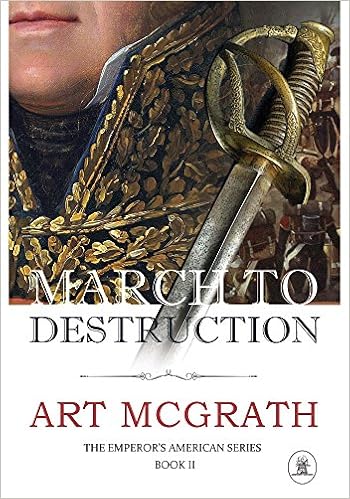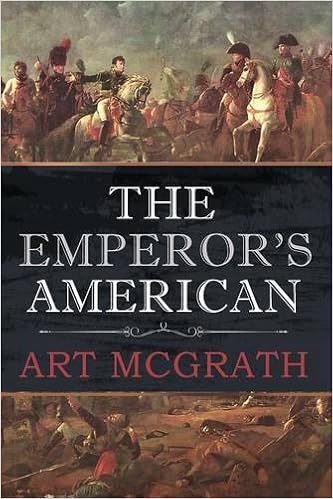In a page-turning
sequel to his debut novel Emperor’s American set during the Napoleonic era,
author Art McGrath continues the adventures of his Franco-Scottish protagonist Pierre
Burns. In March to Destruction Pierre fights in the Grande Armée while
dodging assassins.
MJN: One reviewer
likened your work to Arthur Conan Doyle's "The Adventurers of
Gerard". Was it a comment on the merit or the technique? I
would be more inclined to compare your work to that of Rafael Sabatini. I
believe, the sub-genre is called picaresque?
AM: Well of
course I hope it was on the merit though certainly the comparison in part came
about because of the subject matter. Historical fiction from the French
perspective of the Napoleonic Wars is pretty rare, at least in English. I'm
flattered by the comparison to Sabatini, Marina—we should all be so
fortunate--though I wouldn't say it is a picaresque novel, as it only bears one
or two of the seven traditional elements of a picaresque novel. I would call it
military historical fiction.
If I had to name an author as a model it would be Bernard
Cornwell, who is the current standard by which all Napoleonic military
historical fiction is measured, at least for land combat. He has a formula,
with each novel ending at a major battle. Others in the genre of military
historical fiction, Goldsworthy, Gale, have taken up the formula because it
works. I didn't end book 1, The
Emperor's American, at a major battle because there were none in 1804
and I wanted to acclimate Pierre—and the readers—to French military life and
the period. Book 2, March to
Destruction, does end at a major battle and book 3 will end at
Austerlitz, the greatest of Napoleon's victories. I hope to have that completed
by the end of the year.
MJN: Your protagonist,
Pierre Burns, is an American born to a French mother and a Scottish
father. Historically, there has always been a Franco-Celtic
link, as the French and the Scottish (and especially the Irish) had suffered a
common enemy - the English. Was your choice of the protagonist's heritage deliberate?
AM: Absolutely.
I wanted to give him personal and familial motivation and decided that his
grandfather had fought at Culloden and that he was Catholic. Culloden was in
some ways the last gasp of Scots Catholicism, and the Highlanders largely remained
Catholic until after Culloden in 1745, something I was unaware of until I began
researching the first book in this series. I experimented with a number of
Scots names and regions in Scotland where his family would be from. I also
considered making him Franco-Irish but eventually settled on making him
Franco-Scots, though a major supporting character is Irish. I am of French and
Irish descent and didn't want it to seem semi-fantastical-autobiographic.
And of course I wanted him to be an American because that
gave me a window into this world so as Burns discovers it, so do the readers.
The idea started with an American joining the Grande Armée long before I
decided on his ethnic background.
MJN: Pierre's arrival
in Europe is purely accidental. It's a common technique used by many
great authors to have a down-and-out character plunged into an adventure
against his volition and then find the experience to be incredibly stimulating
and invigorating. In a sense, Pierre is not totally in control
over his fate, but he capitalizes on his own misfortune. Under
different circumstances, do you envision your protagonist choosing this
path deliberately?
AM: You are
right that it is a very specific set of circumstances that led Pierre into the
French Army, an option he would never have considered otherwise. I would say he
is already disposed to do this and just needed the right alignment of the
stars. After all just before he was stranded in Europe he was already fighting
the English on what was for all intents and purposes a pirate ship.
Would he have crossed the Atlantic to join the French
army? That is unlikely, though if he ran across a French soldier returning to
the wars perhaps he would have accompanied him.
MJN: Having "a
price on one's head" in 1805, before photography or social
media, was a little different than it would be now. We have all this
technology to track people down, making it harder to flee from your
enemies. What kind of clues did assassins have to rely on in 1805 to make
sure they got the right person?
AM: In the
case of Pierre Burns, he is not exactly an anonymous figure. He is an
aide-de-camp to a marshal, which means he is in a conspicuous uniform and is
well known. As an aide-de-camp he works and travels alone quite often. He is a
far easier mark in some ways than if he were an infantry officer surrounded by
his men. And let's just say the assassins might have help from within the
French army identifying him and his movements.
MJN: Let's talk about the cover. Many historical novels with a predominantly female audience feature female models in period costumes with their heads partially cut off, leaving just the mouth and the chin visible. Historical novels with a Napoleonic setting often feature tall ships. Were you and your cover artist deliberately trying to deviate from the tradition?
MJN: Let's talk about the cover. Many historical novels with a predominantly female audience feature female models in period costumes with their heads partially cut off, leaving just the mouth and the chin visible. Historical novels with a Napoleonic setting often feature tall ships. Were you and your cover artist deliberately trying to deviate from the tradition?
AM: I have to
give full credit to Christine Horner for the cover. My thought was initially to
go with part of a painting from a battle but she insisted that marketing
research shows that partial close up shots of people and equipment draw readers
in. I was skeptical until I saw the cover and was blown away. I have no idea
whether it was her intention to deviate from the tradition but if it works I
will not argue with success. Everyone who has commented loves it.
As for why there were no tall ships, the novel takes
place hundreds of miles from the ocean. Ships would be out of place but I can
see why people might think tall ships and the Napoleonic era. Fiction about the
era is dominated by seagoing yarns—Patrick O'Brian, Alexander Kent, Dewey
Lambdin, to name but a few. Getting away from that stereotype is one reason I
wrote these novels.
A ship might have worked on the cover of the first book, The Emperor's American, since the
novel opens in the middle of a sea battle but not after that. In fact artist
Tal Dibner, who does many paintings of historical events and people, did draw a
proposed cover for The Emperor's
American which my publisher did not use but now is the cover picture on
my Facebook author's page.


I've read both the first book and its sequel and was most impressed. I'm really looking forward to the next one!
ReplyDelete